

Now that governments are starting to ban insecticides that are the most dangerous to our honey-making friends, a reminder of the situation and the best practices to implement on how to save bees.
For the past 15 years, in countries all over the world, the number of bees has been plunging. Several factors are causing this environmental catastrophe, first among which come urban development, pollution, and the use of pesticides and insecticides in gardens, parks and farmland. As a result, the world honey production is falling. In the end, our entire food chain is at risk, because fruit, vegetable, grain and oleaginous plant survival greatly depend on the pollination work that bees provide.
Acting now is critical!

If you can, eat organic food and support local beekeepers by purchasing their products. Promote bee awareness programs in your area, that help local governments to organize bee protection programs. Some groups even offer hives for “adoption” where you’ll receive honey in exchange for support.

Did you know that bees roam for flowers within about half a mile (one kilometer) around the hive, so it’s best to set them up far away from fields sprayed with pesticides.
Laure Hamann